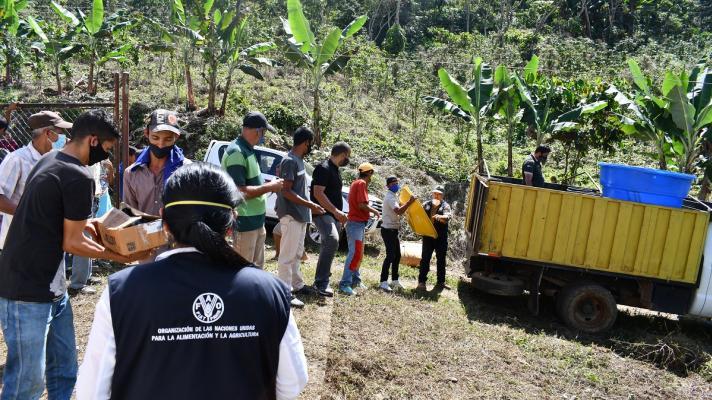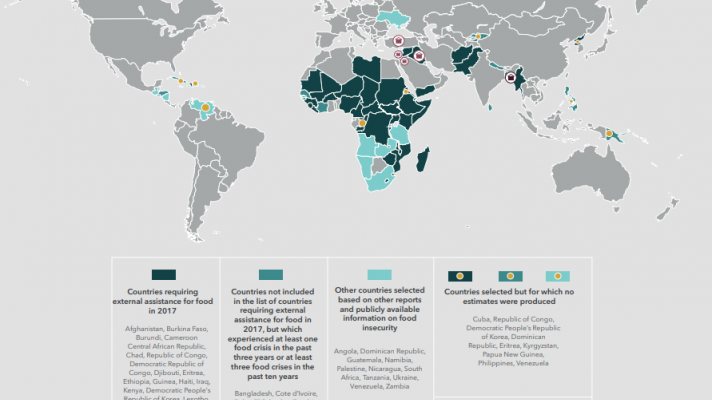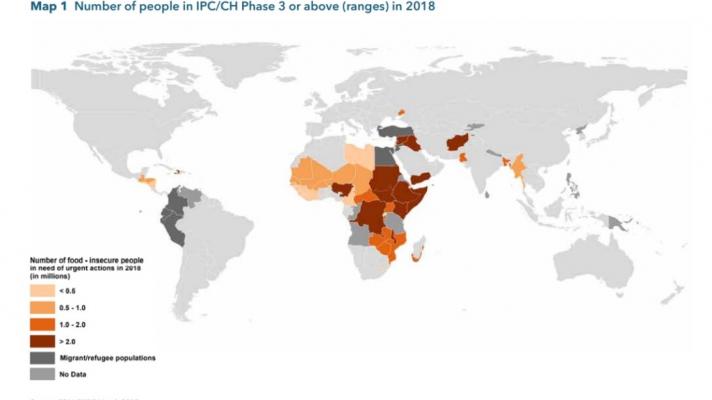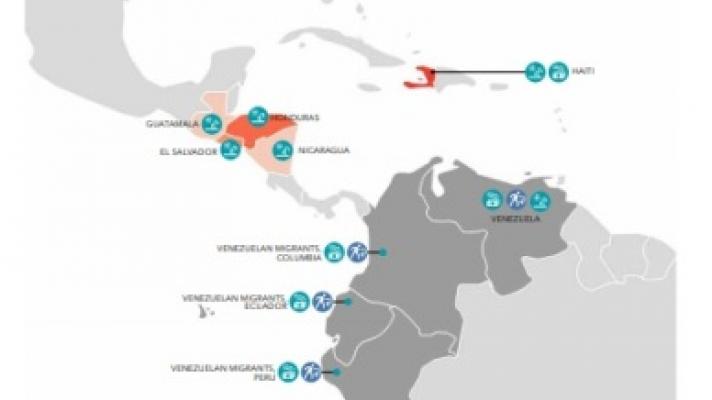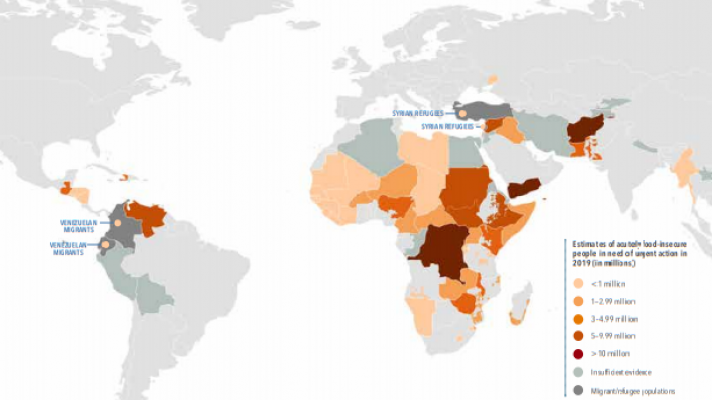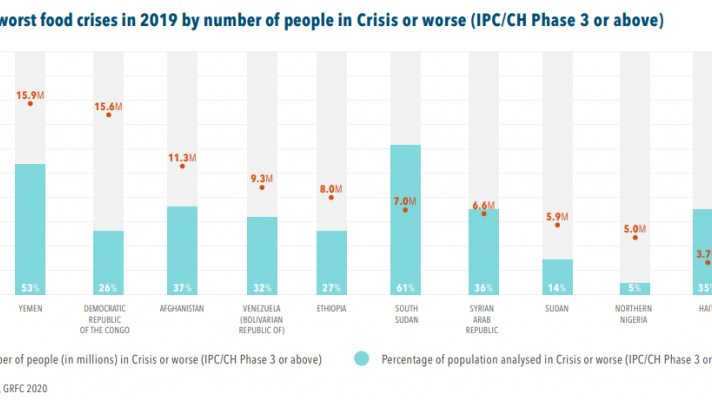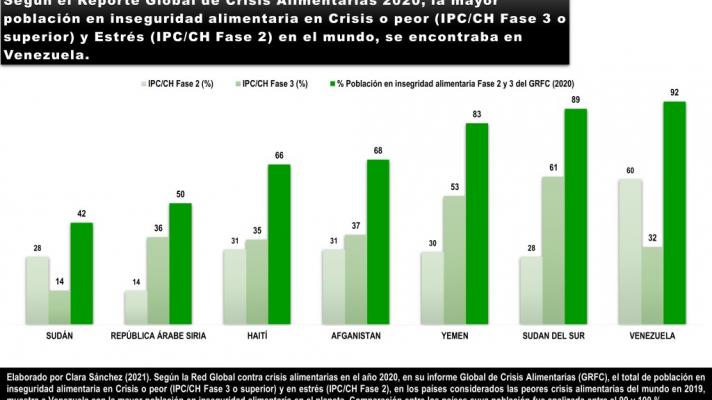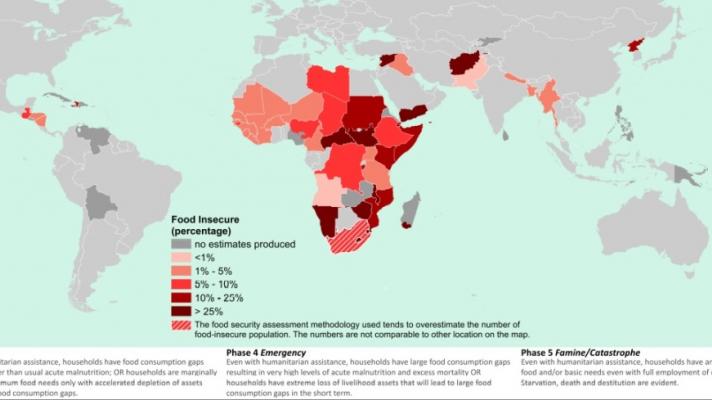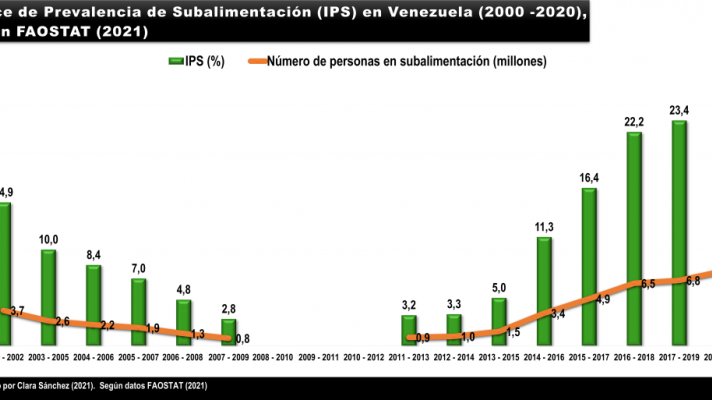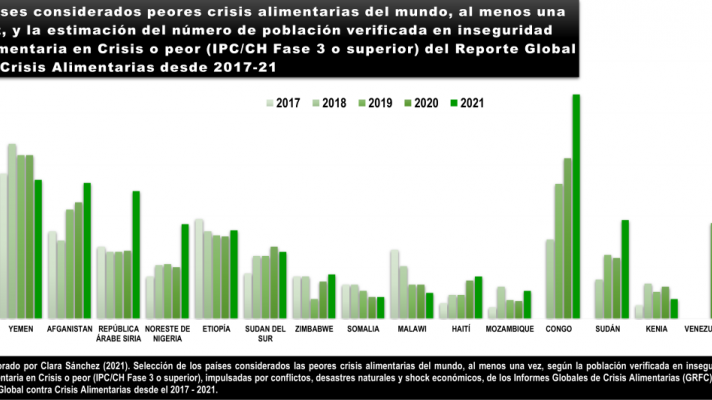Humanitarian intervention
The first part of “The Construction of a Food Crisis in Venezuela” delineated how military options began to be used by the UN to get food to Somalia and Ethiopia in the early 1990s, evolving to the formal use of force to justify interventions on supposedly humanitarian grounds, as in Libya in 2011. It delineated how military options began to be used by the UN to get food to Somalia and Ethiopia in the early 1990s, evolving to the formal use of force to justify interventions on supposedly humanitarian grounds, as in Libya in 2011, to the manipulation of the Venezuelan food situation in the midst of the imposition of coercive measures imposed unilaterally by the United States, supported by the European Union, the OAS, the Lima Group, USAID, big business, and internally by the National Assembly 2016-2020, to insert in the world imaginary the urgent need for a military intervention under the “responsibility to protect” (R2P).
This second part will show the use of UN multilateral organizations as instruments to validate humanitarian crises, promoted by the States of greater power, moved by their own interests and on behalf of the international community, through non-State actors such as agencies, Non-Governmental Organizations (NGOs), the so-called civil society, private actors and even large companies, warning and admitting in turn the possibility of military interventions in which external interference such as that of the United States against Venezuela is not weighted, and where only results of certain situations are revealed, isolating or hiding the cause, which is generally hidden behind conventional, unconventional or diffuse wars, and methods such as the blockade and the generalized siege of Venezuela since 2014.
Food as a human right
In this case, the right to food is dragged into this web of manipulation of human rights, which are part of the securitization process that was carried forward with the concept of human security, formally used between the years 1993-1994 and finally promoted at the Millennium Summit in 2000, where any deterioration of the general categories of this in the economic environments, In this sense, the second part of the second part of the human security doctrine, which was formally used between 1993-1994 and was finally promoted at the Millennium Summit in the year 2000, is based on the idea that any deterioration in the general categories of economic, food, health, environmental, community, political, personal and other environments that have been incorporated over time, has a preventive content through the monitoring of indicators, including the collaboration of large transnational corporations in the resolution of conflicts, among its doctrine of prevention and humanitarian interventions.
The second part of “The construction of a food crisis in Venezuela” is based on the analysis of four types of indicators from different organizations, where high-level multilateral discussions on world food are held, and the reports and specialized publications of the raw records that, as stated by members of official delegations of some countries, and then academics, politicians and journalists only reproduce as first-hand data, whose themes and positions can change radically from one year to another, seeking to go unnoticed, clarifying in advance, without the intention of devaluing the situation of increasing food insecurity in Venezuela, in the midst of the siege suffered by the country since 2014 where the population has been targeted to violate the national government.
Among the indicators, the Undernourishment Prevalence Index (IPS) was taken as well as the Prevalence of Food Insecurity which is measured through the Food Insecurity Experience Scale (FIES), both from the Food and Agriculture Organization of the United Nations (FAO); the CARI or ECRI survey of the World Food Program (WFP); and the Integrated Food Security Phase Classification System (IPC or IPC) of the Food Security Information Network (SFIN), to which FAO, WFP and 14 other organizations, agencies, NGOs, civil society and individuals belong.
For this, it is necessary to emphasize that, when we talk about the FAO’s Undernourishment Prevalence Index, it refers to national estimates of food availability and consumption, as well as caloric needs, which considers the insufficient consumption of food energy in a population, being chronic when not enough calories are consumed, making the case of undernourishment related to hunger and which, in the world today, according to the latest report (2021) of the FAO, reaches 768 million people, 9.9% of the world population. Its scale: <5% is very low; 5% to 14.9% is moderately low; 15% to 24.9% is moderately high; 25% to 34.9% is high; and 35% or more is very high.
In addition to the IPS, since 2014 FAO has been applying the Food Insecurity Experience Scale (FIES), in which, through face-to-face interviews based on the experiences of individuals and households, it highlights the difficulties in accessing food due to lack of availability or lack of economic resources to obtain it. From this scale three levels emerge: mild, moderate (skipped a meal or went without food occasionally) and severe (goes without food for several days, several times a year). The latter is the extreme end of the scale, where the so-called “hungry” or hungry population is found, which complements the GPI or PoU.
Meanwhile, the WFP applies the Consolidated Approach to Reporting Food Security Indicators (CARI or ECRI) survey, through a mathematical tabulation of data collected from households on consumption, deficit, poverty level, proportion of food expenditure and strategies applied to survive, finally building a console whose results, also based on experience, are four levels of food insecurity that it analyzes and reports on a population: secure, marginal, moderate and severe.
And finally, the IPC or IPC, Integrated Food Security Phase Classification, which was originally developed in 2004 for use in Somalia by FAO’s Food Security and Nutrition Analysis Unit, measures together with the Cadre Harmonisé (CH) indicator ‘acute’ food insecurity, having five phases ranging from adequate and stable access to food or Phase 1 and Phase 2 stress, to phases based on the parameters of extreme hunger or Phase 3 (Crisis); 4 (Emergency); and 5 (Famine or Catastrophe).
Phase 3 or IPC/CH Crisis or higher (Phase 4 and Phase 5) is characterized by critical and acute lack of access to food, high levels of malnutrition, and accelerated depletion of livelihood assets. If prolonged over time, it leads to a humanitarian emergency due to excess mortality.
With the IPC or CPI, the creation of the technical consensus of multiple actors and agencies is used to determine the severity of food insecurity, according to experts from different disciplines who discuss ‘reliable’ evidence through the use of secondary data, therefore, it has been considered an accessory to existing information systems, whose purpose is to identify the humanitarian phase that allows emergency responses, a tool to analyze situations and implications of future interventions, according to the severity of the food situation, as well as the possibilities of funding among donors.
In short, with this indicator through consensus, the need for humanitarian intervention is identified, endorsed by multiple actors, classifying ‘acute’ and chronic food insecurity, and beginning in 2019 ‘probable famine’ or acute malnutrition in a country.
Since 2017, the IPC or IPC has been linked to the creation of the Food Security Information Network (FSIN), as an initiative of the so-called Global Food Crisis Network made up of 16 UN agencies, NGOs, civil society, donors and even individuals grouped in the USAID Famine Early Warning Systems Network (Fews Net), the Food and Agriculture Organization of the United Nations (FAO), the Permanent Interstate Committee for Drought Control in the Sahel (CILSS), the Food Security Cluster (FSC), the Global Nutrition Cluster (GNC), the Intergovernmental Authority on Development (IGAD) in the Horn of Africa, the International Food Policy Research Institute (IFPRI) of the Consortium of Research Centers (CGIAR), the Integrated Food Security Phase Classification (IPC), the United Nations Office for the Coordination of Humanitarian Affairs (OCHA), the Southern African Development Community (SADC), the Central American Integration System (SICA), the United Nations High Commissioner for Refugees (UNHCR), the United Nations Children’s Fund (UNICEF), the World Food Program (WFP), the United States Agency for International Development (USAID) and the European Commission, to publish an annual report on Food Crises in the World.
In addition, it participates through IPC’s Global Platform: UK Aid of the Foreign & Commonwealth Office as funding agency, CARE, Save the Children and OXFAM (19 NGOs).
Global Food Crisis Reports are made possible by the ‘generous’ funding of the European Commission and USAID, as acknowledged in each of their publications, apart from being constituted as funding agencies of the IPC or IPC together with UK Aid.
About the Global Report on Food Crises in the World and the case of Venezuela.
In 2015 the Joint Research Center of the European Commission produced a global food crisis report and invited FAO and WFP to contribute additional data, and from 2016 they began to incorporate more partners with the aim of producing a consensus-based report promoted by FAO, WFP and IFPRI.
Since the first report published in 2017, an attempt was made to incorporate Venezuela, Cuba and Bolivia as countries in food crisis, however “lack of evidence and insufficient data prevented the team from estimating food insecure populations”.
In 2018, again the report could read that there were “countries of interest” where “food security was also of concern such as Korea and Venezuela, (also Cuba) but no estimate could be made of the number of food insecure people in these, due to lack of data.”
However, it was advanced that in Venezuela the food crisis could be inferred by the “political instability aggravated by economic crisis”, and in addition there were “6.7 million people depending on the government food distribution program, and according to Venezuelan reports, more than one million people had left the country due to the shortage of basic commodities”. In this case, it recommended “investing in data collection and assessments to ensure that they are not overlooked”.
After some time, this Network is still not concerned about the fact that in Argentina there are 11 million people eating in soup kitchens, that is, depending on government programs.
One of the most interesting details of the 2018 report on Venezuela is the statement regarding “the difficulties to pay the debt, which could lead to stricter economic sanctions for default, which would cause the collapse of the economy”, and in this case, “the government had limited capacity to provide basic services”. In other words, the “sanctions” were not unilateral coercive measures by the United States against Venezuela, not endorsed by the UN, but were justified for defaulting on debt payments.
In 2019, Venezuela was incorporated again, stating that it was among the countries not declared with food crisis in the report, due to lack of validated data, therefore, the need to campaign again for investments in food security measurement system at national and regional level was emphasized.
However, in this one, Venezuela was identified as one of the countries in the world with “the highest number and proportion of food insecure population in 2018” in IPC/CH Crisis Phase 3 or higher by three populations of Venezuelan migrants in Colombia, Ecuador and Peru reaching “0.4 million in South America”, or 400 thousand people (0.3 in Colombia, 0.02 in Ecuador and 0.04 in Peru according to database).
Particularly, ‘economic shock’, a category used for the first time in 2018 to define the driver of food insecurity in Burundi, inter alia, because of “trade restrictions imposed by neighboring countries, the United States and the EU with implications for all Burundians” was considered, was justly selected as the main driver of food insecurity at Phase 3 (IPC/CH crisis or higher) in Venezuela, albeit without mention of the imposition of unilateral coercive measures or “sanctions” against the country as a driver of economic shock, and justified because migrants in Colombia, Ecuador and Peru “had exhausted their means to buy food”.
In addition, based on local organizations that conducted surveys in the country, mainly ENCOVI, they pointed to an increasingly serious humanitarian situation, however it was reaffirmed that “the number of people in need of urgent humanitarian assistance, were not clear due to the absence of reliable data up to that moment”, although it was insisted that it was “evident the deepening of the crisis by the increase of migration to other countries, mainly to Colombia”.
And finally, they summarized that the drivers and risks to the number of people in Crisis or worse (CPI/CH Phase 3 or higher) in Venezuela were an ‘economic shock’ and a ‘climatic’ one, related to the displacement of people with high probabilities that it would continue to worsen in the following 14 months, crowned by “the political stalemate” generated amidst the declaration of Juan Guaidó as “interim leader” recognized by several countries, who “increased pressure to back the self-proclaimed president.”
Year-on-year evidence: the world’s fourth most severe food crisis
In April 2020, and as usual, Venezuela was again incorporated in the Global Report on Food Crises (RCC), finding the evidence from one year to another and finally placing the country “as the fourth largest food crisis in the world with 9.3 million people in ‘acute’ situation of food insecurity”, this would be with 32% of the population in Crisis or worse (IPC/CH Phase 3 or higher), in a report with inconsistencies because, elsewhere, it can be read that there are 9.4 million. Even for the construction of these publications it is difficult to reach an agreement, or rather, it is difficult to reach a consensus.
This 2020 report, with data collected from July to September 2019, states that “about 9.3 million people were ‘acutely’ food insecure”, and I transcribe verbatim: “of these, 2.4 million were considered severely food insecure and 7 million were considered moderately food insecure”. Figures that, when added together, do not give the total figure reported.
This number is the result of the CARI survey conducted by the WFP, published in February 2020, where it estimated “that 7.9% of Venezuela’s population (2.3 million) was ‘severely’ food insecure and an additional 24.4% (7 million) was moderately food insecure”. A total of 32.3% of the population “in need of assistance”.
And although ‘acute’ and chronic food insecurity is what is verified through the Global Network consensus for classifying food crises, in this case Venezuela was taken as the total population identified in the survey, both in moderate and severe (acute) insecurity for Crisis or worse (CPI/CH Phase 3 or higher), thus automatically making it one of the world’s food crises and, at the same time, one of the world’s worst; both for the first and only time.
In addition, 1.2 million Venezuelan migrants were added between Colombia and Ecuador, being in the same situation in these countries. Indeed, this can be interpreted as a lack of improvement in the quality of life of the people who emigrate from the country and, therefore, as in fact is happening, there is a reverse migration, since the beginning of the global pandemic due to covid-19.
However, the narrative about the food crisis in Venezuela has been imposing itself politically, diplomatically and mediatically, as outlined in “The construction of a food crisis in Venezuela (I)”, since 2015 and without verifiable data, until finally reaching multilateral organizations, especially the UN, where they seek to validate humanitarian interventions, and in this particular case under the R2P and hiding the geopolitical interests at stake.
Furthermore, in the Global Food Crisis Report (RCC) 2020 it is constructed that in Venezuela there are additionally 17 million people, which would represent 60% of the population, in marginal food insecurity (IPC/CH Phase 2), imposing in total 92% of the Venezuelan population within the country with food insufficiency. This would be only 8% not reached by this situation, around 2 million, according to their “calculations”, where they assume that Venezuela has 28.5 million people.
Highlighted as an extraordinary fact because it draws a Venezuela, and so reflected in their “calculations”, with the highest percentage of population in food insecurity in the world, surpassing even the populations in extreme vulnerability of South Sudan (89%), Yemen (83%), Afghanistan (68%), Haiti (66%), Syrian Arab Republic (50%) or Sudan (42%), positioning the country in a proportion that suggested the highest on the planet.
All to justify the placement of Venezuela as the “fourth largest food crisis”, generated by nothing more and nothing less than an ‘economic shock’ casually, to the tune of Elliott Abrams, “man-made”. And only in a footnote can one read: “the economic sanctions imposed on Venezuela further limited export revenues and access to external financing”.
However, in the overall picture of malnutrition “in terms of Prevalence of Undernourishment were seven countries: South Sudan, Yemen, Central African Republic, Zimbabwe, Afghanistan, Syrian Arab Republic and Haiti, the world’s leading food crises, each with more than 35% of their population analyzed in Crisis or worse (CPI/CH Stage 3 or higher).”
And if it does not seem exaggerated to state that 92% of the Venezuelan population suffers from food insecurity, above other nations really affected by hunger, and in extreme conditions of armed and open conventional conflicts and natural disasters for decades, this Global Network against Food Crises “expects economic hardship to intensify on the remaining Venezuelans in the country”, and with the pandemic in 2020 hunger will extend to 100% of the population.
The ultimate goal of this 2020 report is to lay the groundwork for Venezuela as one of the worst food crises in the world, where urgent humanitarian assistance is required, inserting in the world imaginary the need for “humanitarian” military intervention or R2P.
From one year to the next: no evidence
And as the RCC report is published every year, in 2021 it returned its fifth edition with which Venezuela continues to appear as a country of interest of this Global Network against Food Crises, even though it is explained that “although the Bolivarian Republic of Venezuela was among the 10 worst food crises in 2019, there was insufficient evidence to include it in 2020”.
But it goes on to imply that “although ‘acute’ food insecurity estimates for Venezuela are not included in the 2021 RCC due to insufficient evidence (…) the data suggest that this major 2019 food crisis ‘probably’ worsened in 2020”, even though one can explicitly read therein that, “it reflects the existence of data gaps/insufficient evidence to produce estimates of people in Crisis or worse (CPI/CH Phase 3 or higher).” And not only in Venezuela: the evidence on the migrant population of Colombia, Ecuador and Peru disappeared from one year to the next.
That is, they do not have, perhaps because they do not exist, the evidence to suggest that in Venezuela there was the fourth most serious food crisis in the world in 2019, and that from one year to the next it ceased to be so. An extraordinary luck that other countries have not had, as will be shown below.
And although it is reported in the RCC 2021 that Venezuela was included only once from 2017 to 2021 as a global food crisis, and also considered one of the worst in the world, a position shared supposedly for ‘only once’ with the Democratic People’s Republic of Korea and Sierra Leone, the reality is that neither was shown as one of the worst food crises (even estimating the former 10.1 million people and the latter 3.3 million in acute food insecurity, in the same 2020 report), as did happen with Venezuela after having been selected regularly and year by year for inclusion.
However, the fact that there are “data gaps” and “lack of evidence” to continue promoting Venezuela as one of the worst food crises in the world does not prevent insisting that “economic collapse, covid-19 restrictions, insecurity and climate extremes fueled an already severe humanitarian crisis”, being that the ultimate goal: the construction of a narrative that facilitates military intervention as the ultimate means to achieve the regime change proposed by the United States, endorsed by the European Union and the United Kingdom, whatever they call it, and try to disguise it with different attires.
And of course, the 2021 report could not fail to make reference to USAID’s perspective regarding Venezuela and the worsening fuel shortages, in addition to the covid-19 that will “probably” limit food distribution and access to markets, as well as expressing concern about the large influxes of migrants returning to the alleged humanitarian crisis during the pandemic which, in any case, means less needy to justify donors interested in providing humanitarian aid for these abroad.
Agency of the United States that, apart from funding food crisis reports year after year along with the European Union, donated $507 million to address the “humanitarian crisis” in Venezuela from 2017 to 2019, and as it has reported “aligned its adjudication and decisions aimed at reinforcing the credibility of the provisional government of Juan Guaidó”, minimizing the delivery of funds to UN agencies with infrastructure in the country to deliver humanitarian goods, because the “interim” was concerned about the support of the United Nations to the government of Nicolás Maduro.
Going so far as to only finance requests from Venezuelan NGOs that supported the foreign policy interests of the U.S. government in Venezuela, leading to the manipulation and use of humanitarian aid for political purposes, of whose donations only $2 million were used to purchase and transport 368 million tons of humanitarian goods, of which only 8 metric tons were delivered to the country as of August 2019.
Why Venezuela and not other countries in Latin America and the Caribbean?
In 2021, it also published “Hunger Hotspots. FAO-WFP early warnings on acute food insecurity. Perspectives from March to July 2021”, where it is stated that “the food security situation in Venezuela is likely to deteriorate even more as a result of hyperinflation”, that is, due to the economic shock, and for the first time it is considered the “hardening of international sanctions”, although they do not refer to the unilateral coercive form of the same, mainly by the United States.
Furthermore, in accordance with USAID’s concern, they add “the impact of the restrictions related to covid-19 and fuel shortages, affecting logistic and agricultural activities” which, although they are presented as independent variables, in Venezuela their impact is closely related to the imposition of the economic, financial and commercial blockade against the country, especially with regard to essential supplies such as energy.
And in this sense, Venezuela is again reflected, together with Syria, within the 23 countries with the highest number of people in a situation of ‘acute’ food insecurity in the world, even when the population is not considered in Crisis or worse (CPI/CH Phase 3 or higher), based on the same CARI survey applied by the WFP in 2019, with which the country was considered, a year before, as the fourth worst food crisis in the world.
WFP that in 2021, in agreement with the national government, will focus attention on preschool and early education schools to serve 185 thousand children in 2021, estimating to reach a total of 1.5 million schoolchildren by 2023, and among other things invest in rehabilitation of canteens and training of personnel in food safety practices, adding this to the 18 food programs developed by the Bolivarian Revolution, and particularly through the School Feeding Program (PAE), which serves 5 million 930 thousand students in schools.
For this reason, apart from the analysis of the Global Food Crisis Reports from 2017 to 2021, due to its deep interest in alerting of a possible famine in Venezuela, it is also necessary to point out the lack of the same and alarm for populations of other countries in Latin America and the Caribbean such as Argentina, Brazil or Mexico, which will be used only as an example because they are considered the main economies of the region and have the largest populations, taking into account that smaller nations, even if they have a high percentage of people in ‘acute’ food insecurity, will never be considered as worse food crises because of the proportion, as long as it is measured by the number of people.
For this, we use the Food Insecurity Prevalence of the Food Insecurity Experience Scale (FIES) applied by FAO since 2014 and, in a way, the IPC or CPI that determines food crises also benefits from it.
In 2021, FAO updated “The State of Food Security and Nutrition in the World” which allows comparing some data that are powerfully striking, in terms of alerting possible food crises that are not tracked in terms of the number of people, since 2016, as is the case with Venezuela.
The first case is Argentina, which although it has an Undernourishment Prevalence Index (IPS) of 3.9%, the prevalence of moderate and severe food insecurity (FIES) reaches 35% of its population or 16 million people, being 5.7 million in severe conditions.
Even Brazil, whose GPI remains at less than 2.5%, according to FIES, had in 2020 23.5% of its population in moderate and severe food insecurity, which is 49.6 million people; of these, 7.5 million in severe conditions. Both populations are from the two largest food producers in the world that, at the same time, cannot feed their entire population due to lack of availability and economic resources, i.e., restricted access to food.
Mexico serves as a third example, with a GPI in 2020 of 7.2%, indicating 9.2 million people in undernourishment or hunger, but if we review the prevalence of moderate and severe food insecurity of the FIES, it reaches 26.2% or 33.2 million people; of these, 7.4 million in severe conditions.
So, if for Venezuela, according to WFP (2019) were 9.3 million people in moderate and severe food insecurity, of which 7 million were considered in moderate insecurity and 2.3 million in severe insecurity, served as evidence by taking the population identified in the survey for Crisis or worse (IPC/CH Phase 3 or higher) by the Global Food Crisis Network, and thereby qualifying the country as the fourth worst food crisis in the world, we would have to ask ourselves:
Why do 16 million people in Argentina, or 49.6 million in Brazil and 33.2 million in Mexico, not generate flashes of alarm or are they considered countries of concern, nor is food insecurity a cause for concern?
And we raise this simply because when in Venezuela began to register an increase in GPI, reaching in 2017, according to FAO records, 3.1 million hungry people, it was already considered a country of interest and cause for concern by the Global Food Crisis Network.
Did the fourth most serious food crisis in the world exist or not in Venezuela?
In 2020, the FAO’s Panorama of Food and Nutrition Security estimated the Undernourishment Prevalence Index (IPS) for Venezuela at 31.4% in the three-year period 2017-2019, that is 9.1 million hungry people as of 2019, 300 thousand less than those considered in ‘acute’ food insecurity in the Global Report on Food Crises, with which the country was declared the fourth worst food crisis in the world.
Likewise, the report made a projection for 2030 of 61.7% of the Venezuelan population with hunger, that is, 20.1 million people according to the IPS, which would imply the total population in catastrophic conditions of famine taking into consideration that the prevalence of moderate or severe food insecurity would also increase. And all because of an economic shock.
On the other hand, FAO in “The State of Food Security and Nutrition in the World” (2021), in the following three-year period 2018-2020 estimated a GPI of 27.4%, that is, 7.8 million people are those who are undernourished in Venezuela, referring this to a decrease in hunger by 1.3 million people by 2020 compared to 2019.
However, when we refer to the FAOSTAT online publication (2021), the GPI in the 2017-2019 triennium does not reach 31.4% of the population but 23.4%, that is, 6.8 million people and not 9.1 million in 2019, nothing more and nothing less than 2.3 million people less, thus also validating Venezuela as the fourth worst food crisis in the world.
And when reviewing the triennium 2018-2020 in the same portal, the GPI amounts to 27.4% or 7.8 million people in undernourishment, and although the FAO constantly updates its data, what this latest publication refers to is that in Venezuela, in 2019, it was catalogued with a prevalence of ‘high’ undernourishment when it did not yet exist; it can even be added that the GPI in Venezuela did not reach 9.1 million people.
This generates an alert for the risk of manipulation of world food indicators, mainly by non-state actors, added to the pressure of interested donors such as USAID, European Commission, Foreign & Commonwealth Office and others on multilateral organizations that require funding.
Measurements that, even coming from ‘reliable’ sources, can be used to validate “humanitarian interventions” or R2P with hidden geopolitical interests, or even more, when foreign interference is evident, particularly from the United States, supported by the European Union and the United Kingdom, to stifle the Venezuelan economy and generate suffering in the population to help achieve a change of regime or government under the umbrella and the discourse of the defense of human rights.
Supposed humanitarian interventions, of which there are many references in the world, that with the passing of time generally do not resolve the humanitarian situations and the intervened territories remain in worse or equal conditions to those found. To cite an example: Haiti, but can be almost all countries considered worst food crises in the world from 2017 to 2021.
Therefore, although it is evident the increase of food insecurity in Venezuela, whose growth has been proportional to the amount of “sanctions” and actions imposed by the United States, on the other hand it is logical to question the existence of the worst fourth food crisis in the world in the country during 2019, without evidence before or after; an extraordinary “luck” that has not been enjoyed, for example, by entire countries or territories in armed conflicts or climatic shocks such as Yemen, Afghanistan, Northern or Northeastern Nigeria, Syrian Arab Republic, South Sudan, Sudan, Ethiopia, Malawi, Zimbabwe, Haiti, Mozambique, Democratic Republic of Congo, Somalia or Kenya, where sufficient evidence is found each year to verify populations in ‘acute’ food insecurity or Crisis or worse (IPC/CH Phase 3 or higher – Emergency Phase 4 and Famine or Catastrophe Phase 5), and there are no data gaps.
Moreover, if we use the CPI Global Platform Integrated Food Security Phase Classification Mapping Tool 2019-2021 on ‘acute’ food insecurity in the world, as well as the 2016-2021 series on chronic food insecurity, the absence of Venezuela can be observed in the following maps.
Concluding remarks
In 2021, FAO again identified armed conflicts and climate variability and its extremes, definitely adding economic slowdowns and recessions, as the main drivers of hunger in the world.
This third driver is the one that has been related in Venezuela, since 2015, to the increase in undernourishment and food insecurity, a ‘man-made’ ‘economic shock’, which FAO (2021) finally refers to “economic slowdowns and recessions, regardless of whether they are driven by market swings, trade wars, political unrest or a global pandemic, such as the one caused by covid-19”.
In the face of this, FAO proposes actions to integrate humanitarian policies, increase climate resilience and the resilience of those most vulnerable to economic adversity, intervene in supply chains, address poverty and inequalities through enabling interventions, and strengthen food environments to improve consumption patterns, etc.
But will the FAO ever be able to denounce as an international organization that some actors put pressure on others to intervene diplomatically, economically, financially, commercially, politically and even in the media, thus harming populations around the world that the multilateral organization then includes in its statistics to advocate for them on a humanitarian basis?
In the Venezuelan case, the systemic crisis of oil prices was evidently a means used by the United States to try to end Venezuela as a nation-state, through the imposition of unilateral coercive measures not endorsed by the UN, which over time have been shown to violate the human rights of the entire population, through which no one is shot but generate a level of devastation depending on the severity and application of the same in time and space to achieve the crushing of an economy, such as war or bombing with each “sanction” or action imposed.
“Sanctions” that since 2015 would be 352 bombs (only from OFAC) falling on Venezuelan territory consecutively. Another alert for the rest of the nations that still believe that in Venezuela only an economic shock occurred, coincidentally and coincidentally since the country was declared an unusual and extraordinary threat against the national security of the United States.
Economic shock driving food insecurity in the country, actually propitiated by the severity of the unilaterally imposed “international sanctions”, which can continue to be used disproportionately and as an effective means against any nation, whose damage can be equivalent to war for the destruction of infrastructure, although not instantaneously, cause suffering to the population and violate their rights to food, health, medicine, water, transportation and other services, which by its systemic nature also violates the right to an alternative development of a country, whose actions to address it are not only those proposed by FAO, is not to expand and advocate for more humanitarian aid and resilience: It is to raise our voice so that all unilateral coercive measures are eliminated.
In other words, the blockade.
And since this form of unconventional warfare, protected by the economic, financial and commercial blockade, has been imposed on the Republic of Cuba for 60 years, extending more and more to other nations and being stealthily imposed on Venezuela since 2015, and in view of such a forecast by the FAO for the Venezuelan population in the year 2030, in relation to food, there is no other option but to overcome the conditions of vulnerability in this matter.
That is to say, to overcome the configuration of the Venezuelan dependent agro-food system from a peripheral position subordinated to the world hegemonic power, and why not, to become a successful model of economic, political and cultural insubordination. There are also examples of this in the world.
This article was originally published on the Food and Power website on August 4, 2021.
Translation by Internationalist 360°
